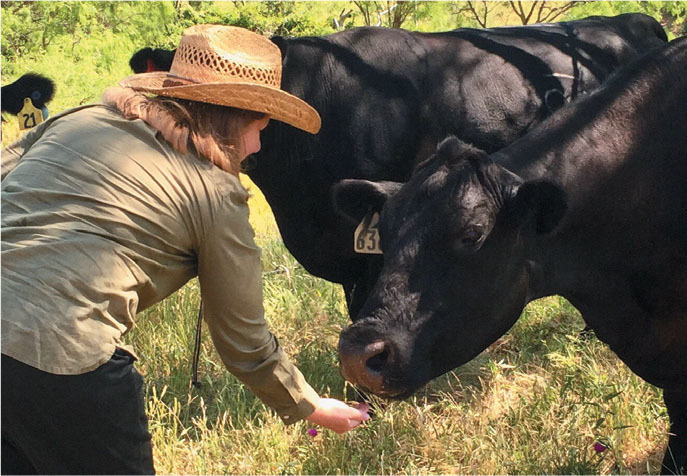
Case management skills are all about effective communication with different populations of people: pediatric, adult, elderly. Some are better communicators and some may not be strong communicators. Have you ever tried to understand a baby’s needs or small child when they don’t want to talk about their symptoms at a pediatrician’s office or as an in-patient? I am sure you can relate to this scenario.
When we moved to Texas, I continued to work in a leadership role in case management during the week, and work on a new family ranch on weekends. There was a small herd of cows on the ranch, and I wanted to interact with them in some way. I wondered what cows could understand. Would cows understand the content of a conversation (verbal communication) with them or were they sensitive to non-verbal communication. wanted to find out if cattle would respond to friendly quiet voice tones, verbal and nonverbal communication. I did not realize there was a parallel between communicating with children and communicating with cattle. I soon found that my case management skills were helpful on weekends on the ranch as well.
Since I did not grow up in Texas with cattle, I had a fresh view of these large lumbering black Angus animals when I arrived from southwest Pennsylvania. Angus cattle, as I learned, was a Scottish breed of black or red beef cattle from the counties of Aberdeenshire and Angus in north-eastern Scotland. Growing up in a suburban environment, I saw cattle differently and wanted to understand them more.

A local rancher advised that I get to know the herd by approaching them by slowly backing up toward them. Walking toward the herd would result in them moving a distance away. Walking backward allowed the cows to a non-threatening situation and they held their ground. To foster more interaction, I came up with an idea! I wanted to reach out to them by reading a children’s book. My case management friends scoffed at this idea. I was determined, however, to give reading a try. Since I wasn’t sure how they would react, I stayed behind a fence. I sat on a high stool and began reading a story to the cows. I was surprised to find that they crowded around in front of me and began pushing each other out of the way to see the pictures—just like kids would do. I was amazed. They really seemed to enjoy the interaction of reading in a positive melodic voice. I bought other children’s books and kept reading. Or was it the bright colorful pictures of cows in the books? “How the Cow Jumped over the Moon” by Sally Huss turned out to be their favorite book!
Sheepishly sharing the success of reading to cows with a small number of people in a rural town, a request came back to share a picture of reading to the cows. The first grade teacher was struggling with a few children who were not motivated to read. To children living in rural areas with cowspeckled rolling hills, cows were important to them. I believe that they connected with the picture of the cow and now wanted to learn to read. The teacher was thankful for the picture, and her young students became avid readers.
Soon it was summer and the cows would walk to shaded areas of the ranch to avoid the bright hot sun. I thought perhaps a frozen chunk of ice would be refreshing for the cows during summer days. I froze water in a plastic open container and emptied it out on a shaded area of hay. The cows looked curiously at the chunk of ice on the ground, then surrounded it with excitement when they realized it was iced water. Another success! I shared my story with the same local rancher who said to add flavored drink mix to the water and it would become a cow popsicle that the cows would like even more. I tried it and another children’s favorite became a cow delight! The cows seemed to like cherry flavor the best. Providing a cold treat as a comfort measure, whether it was a child or a cow, was a way to utilize my clinical nursing and case management experience.

PHOTOS BY KIMBERLY JUNGKIND
As I was setting up one day to read to the cattle, one large cow sat down in front of me and stared at me. This was quite unusual, and I wondered what this meant. She seemed sad with her head down. When I approached her slowly, she stayed on the ground. I spoke to her quietly in a hushed tone knowing that she may not understand my words. I asked what was wrong and slowly, she looked away turning her head revealing that she had a weeping eye infection. I tried to wipe off the excess as she kept her head still, knowing that it was important to gain her trust. Realizing that I needed expert advice, I contacted the large animal vet who examined, irrigated and treated the infected eye. She was back on the ranch later that day looking exhausted. I learned that cows, just like children, can react in similar ways. Again, I was closer to my clinical case management experience and knew that eye infections needed attention quickly.
Later in the fall, one of the very pregnant Charolais cows was having difficulty birthing her first calf. Charolais cows are descended from white cattle bred in Charolles and Nieves, France. These cows are fiercely dedicated moms. After I chased the very pregnant mother cow in a fenced in 16-acre pasture, the Charolais cow was exhausted and followed me to a safe special holding area in the corral with plenty of hay on the ground. The expertise of the same local rancher was key to a safe delivery. He used a “come along” device for helping to birth a cow. Soon a beautiful brown calf was delivered, which delighted the Charolais cow mother. The Charolais cow mother was thrilled initially. Her enthusiasm turned to sadness as the new calf could not stand after a day, even after lots of struggling. The calf died in the soft hay. It was a sad event. The next day, after the calf was removed, the mother was in distress and inconsolably mooed. She was anxious to find an explanation. There was no explanation. I spent time with her every day to visit her, speaking quietly and slowly to reinforce that she was a good mom and that there would be other calves in her future. I am not sure what she understood. The Charolais cow mother, flanked by other large cows, seemed to protect herself from the world and others trying to communicate with her. I finally gained her trust and the trust of the cows protecting her, to speak with her closely and provide solace during this recovering time of stress. Again, I learned about using my case management skills of empathy and building trust with soothing verbal tones to decrease stress so that healing can begin.
In an effort to bring the cows together after this tragedy, I thought of playing quiet music for the herd of cows. I wasn’t sure how the cows would react to music, but I thought it was worth a try. After feeding them one day, I played quiet orchestral music. Children love to be tucked in to bed with this kind of music and read a story. The experiment was a success! The cows loved soft orchestral music and classic symphonies. The cows would gather around the music and stare at the “box” (speaker). The cows were very inquisitive when hearing the music at first then sauntered over to a shady tree and took a nap or just rested with their eyes slightly open, captivated by the harmonic sounds. They voted with their feet as they walked away when pop or rock music was played. They walked back, however, when they heard Italian opera or background music to famous movies that captured the same genre.
“Cow Concerts” became a weekend routine, and the cows seemed to look forward to it. When I added stories to the music, they were not interested and walked away. It was clear that they enjoyed the music. When the cows listened to soft music, they were more docile and approachable.
As a weekend ranch hand in Texas, I have learned a lot that has expanded my case management skills. It’s important to continue to hone your skills through conferences, reading journals and unique experiences. You can also grow and challenge your skills by finding unique, memorable opportunities.
In the future, we may learn that there are deeply embedded levels of understanding that cows possess. In the meantime, cows and kids do respond to a gentle touch, a quiet calm approach at times of stress, and this approach leads to trust over time.




